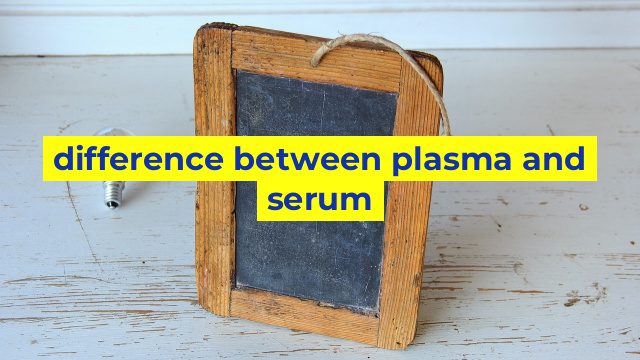Understanding the difference between Plasma and Serum in Medical Science
As we all know, plasma and serum are two important components of the blood that play a significant role in maintaining our overall health. While both are liquid substances present in our blood, there are quite a few crucial differences between the two.
What is Plasma?
Plasma is a yellowish liquid that is derived when the blood is centrifuged, and the red blood cells are separated from the remaining fluid. Plasma plays a crucial role in transporting nutrients, hormones, and other essential substances to different parts of our bodies. It also helps in removing waste products, toxins, and other harmful substances from our system. Plasma also contains clotting factors responsible for coagulating the blood, thereby preventing excessive bleeding.
What is Serum?
Serum, on the other hand, is obtained by separating the liquid that remains after blood clots. As you might have guessed, serum lacks some of the clotting factors present in plasma, and hence it doesn’t contain fibrinogen, which plays a critical role in clotting. Serums contain essential substances like antibodies, hormones, and electrolytes, which are fundamental for the proper functioning of our body.
The key Differences between Plasma and Serum
One of the essential differences between plasma and serum is the fact that plasma contains clotting agents, while serum does not. This makes plasma a better choice for diagnostic purposes, as it allows for the identification and monitoring of coagulation disorders, while serum is typically used for diagnostic testing since it doesn’t contain clotting agents.
Another critical difference between the two is the fact that plasma is considered to be a better source of nutrients and other essential substances, as it contains more proteins when compared to serum. This makes plasma a popular choice for patients who have lost a significant amount of blood, as it can provide much-needed nutrients and help with the recovery process.
Conclusion
In conclusion, while both plasma and serum are vital components of our blood, they have some crucial differences that should be kept in mind. Understanding these differences can help medical practitioners make more informed decisions when it comes to diagnosis, treatment, and patient care. So regardless of whether you are a medical professional or a patient, a basic understanding of the difference between plasma and serum can go a long way in ensuring better health outcomes.
Table difference between plasma and serum
| Difference between plasma and serum |
|---|
| Plasma: |
| 1. The fluid portion of blood that is collected after clotting agents are added. |
| 2. Contains clotting factors, such as fibrinogen and prothrombin. |
| 3. Can be used in blood transfusions to help restore blood volume or clotting factors. |
| Serum: |
| 1. The fluid portion of blood that is collected after clotting agents are allowed to form a clot. |
| 2. Does not contain clotting factors, as they are consumed during the coagulation process. |
| 3. Often used in diagnostic tests, such as blood glucose or cholesterol levels. |

